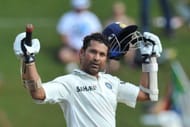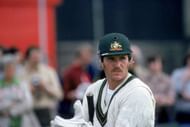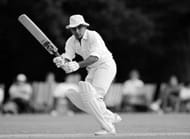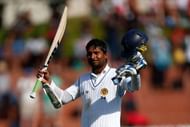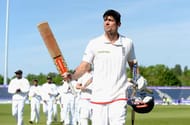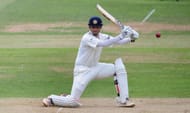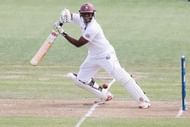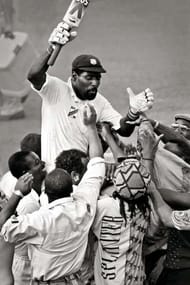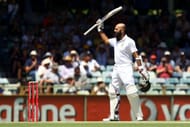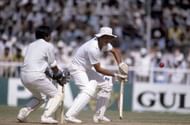Pace bowlers are probably the Thors of the cricketing world – loved and feared, brutal, aggressive, and dominating. They bring the zing into cricket, coaxing life equally out of all surfaces, spicy and placid. But, what is cricket if there isn’t any contest and hence we are thankful to those gritty batsmen, soaked in gumption and drenched in tenacity, who handle pace bowlers, sometimes like men possessed.
This piece is a tribute to such batsmen – batsmen who have tamed bowlers in their own den and batsmen who have survived devastating spells. Picking the top 11 batsmen against pace bowlers is always a tough ask for the following reasons:
#1 Across eras, the quality of fast bowling has varied. The mantel for being the scariest fast-bowling den has changed hands quite a bit. West Indies owned it for nearly two decades in the 70s and 80s. Australia had a good spell during the 80s and then again in the first decade of the 21st century.
Pakistan was scary between ‘85 and ‘95 as the Sultans of Swing terrorised the batsmen home and away. South Africa’s battery of fast bowlers has always been on full charge especially at home. So picking batsmen from across eras from different countries is a really tough ask.
#2 Over the years, cricket has evolved whether in the size of bats and protective gear or the nature of pitches and repertoire of fast bowlers.
#3 Some of the best batsmen of all time looked so invincible partially because they never had to face a generation of great fast bowlers from their own team – Ricky Ponting and Jacques Kallis come to mind immediately.
#4 Stats could be elusive considering there are always anomalies. Boiling it down to how many a batsmen scored precisely against the great fast bowlers is hard data to find, almost like sifting through a haystack for a needle. Different batsmen scored in different countries against different batteries of pace bowlers leaving very little commonality for us to compare.
#5 We have excluded from the list, batsmen from the era of uncovered pitches. The advent of safety gear, especially helmets, in itself, has changed to a certain extent the batsmen’s ability to tackle fast bowlers. It is hard to compare the Laras and Tendulkars against greats like Don Bradman, Walley Hammond, Len Hutton, Herbert Sutcliffe and Sir Jack Hobbs.
But we try to do what we try to do – extrapolate, pick a few stats that talk about the batsman’s ability and compare it to others with similar history and equally good numbers. Here are some criteria that I have used to pick the batsmen on the list, although, there is a lacuna that the reader as always is more than welcome to fill. Some of the factors we considered are:
- Averages against West Indies during their heyday between 1970 and 1995 in their own den.
- Averages in matches that involved Michael Holding, Malcolm Marshall and Andy Roberts together – not a big set but there is some data we could use from there.
- Averages against Australia during the first decade of the 21st century, with most matches including the duos of McGrath-Gillespie or McGrath-Lee.
- Averages against Australia in their own den at any point of time.
- Averages against the Sultans of Swing – Wasim Akram and Waqar Younis – playing together.
- Averages against South Africa in the Saffers’ own den from the time they were reinstated back into the cricketing fold, given the nation’s ability to produce great fast bowlers constantly.
- Averages in matches that had Dennis Lillee and Jeff Thomson (probably the world’s fastest bowler) playing together.
The drawbacks of such calculations include these considerations:
Although batsmen have high averages against teams that possess great fast bowlers, there is no guarantee those runs were actually scored against the great fast bowlers. A great example is Sachin Tendulkar’s outstanding knock of 146 in Cape Town, in one of the most mesmerising duels of all time, against Dale Steyn.
Sachin scored only 23 runs off Steyn having faced as many as 83 balls. But to his credit, he survived and therefore, shielded other batsmen from that phenomenal spell. Even if we take a look at batsmen and their individual averages against particular bowlers, those runs will include runs scored at home and away across various conditions, under varying pressure.
There is almost always support for batsmen and it is hard to be objective about batsmen and their performances against fast bowlers.
At the end of the day, it is not all about runs though and if a batsman has survived a tough attack, runs or no runs, he deserves some credit. This blog, in particular, is an excellent study in itself where batsmen have been compared based on their averages against high-quality bowling attacks, divided on a median to find some common ground between batsmen across eras and across various nationalities.
This is a Herculean task though and cricket at the end of the day, is as much a sport of impressions and the artistry as it is about cold stats staring at you.
Sachin Tendulkar
Considered by some as the best batsman of his era, certified by the great Don Bradman himself of having gifts similar to those of Don, Tendulkar is probably the only batsman amongst his contemporaries who has faced all the great fast bowling generations – the West Indies of early 90s, Pakistan of the early 90s, Australia of early 2000s and South Africa through the 90s and 2000s.
From swing in England to pace in Australia, especially in Perth, and bounce in Durban, Sachin has faced every type of seam attack and has come out with flying colours.
He is No.4 on the list of visiting batsmen with most runs in Australia – 1809 at an incredible average of 53. Only two greats, Jack Hobbs and Herbert Sutcliffe have a better average after scoring 1500 runs in Australia. Sachin also tops the list of most runs scored against South Africa in South Africa by a visiting batsman – 1161 at 46.44 with 5 centuries.
Sachin also averages close to his normal average against bowling attacks which were above the median (in terms of ferocity) especially away from home. Most importantly, his playing style was as correct and complete as it could get, without an obvious flaw.
Good off the front and the back foot, offside and onside and with the drives as well as with the cut, pull and hook, showing he possessed rare dexterity when it comes to dealing with pace bowling!
Allan Border
The man who toppled Sunil Gavaskar’s run tally in Tests, Border, besides being a great leader, who spearheaded the Australian renaissance was also a gritty batsman. Between 1970 and 1995, Border is fourth on the list of most runs against West Indies in West Indies – 796 runs at 53.
Border’s entry into the list is on the basis of one very important credential – his average doesn’t vary much with the quality of bowling attacks, over the median, below the median, home or away – the sign of a truly reliable batsman. That level of consistency against various bowling attacks has been achieved only by a few other batsmen – the likes of Tendulkar and Sangakkara.
Border played a lot of his cricket on the fast bouncy pitches of Australia and also against a high-quality West Indies side through the 80s, a time when you couldn’t thrive without being good at dealing with pace bowling. Border also averages 59.5 against Pakistan, which has always been known for its pace bowlers overlapping with Border’s career.
The greatest aspect of his cricket is the fact that Border averages above 35 in all countries, 38 being the lowest, against South Africa where he played just three Tests and 46 being the next lowest in his own country.
Sunil Gavaskar
Questions have been raised in the past over the fact that Gavaskar’s best runs never came against the great quick bowlers of West Indies. While facts can be twisted the way you like, simple stats really vindicate the first man to reach 10000 runs in Test cricket. Gavaskar averaged 49.6 in 7 Tests against a West Indies team that had the three great West Indian fast bowlers – Holding, Marshall and Roberts.
While it can be argued that Gavaskar averaged 30 in 5 of these Tests played in West Indies that would be absolute nit-picking. Gavaskar is also miles ahead of anyone in terms of runs scored against West Indies in West Indies (1970 - 1995) – 1404 at 70 with 7 centuries.
Mohinder Amarnath is a distant second with 877 runs. Gavaskar also averages 51 in Australia against Australia having scored 920 runs, an average higher than those of Sir Vivian Richards and Clive Lloyd. He also averaged 56.45 against Pakistan pitted against the likes of Imran Khan.
Kumar Sangakkara
Sangakkara, who was a wicket-keeper for a big chunk of his cricketing days, almost has a Bradmanesque average amongst contemporaries. Like Indian batsmen, he had to bear the brunt of playing high-quality fast bowlers from around the world, without having much practice against his own, brought up on low, slow pitches.
He averages 60 in Australia, 41 in England, 61 in New Zealand and 35.75 in South Africa. His numbers are better overall, especially against the same teams at home. More importantly, Sangakkara, is one of the few batsmen from the sub-continent who have scored runs around the world under all conditions.
Add to that the elegance of a southpaw and we have a definite hit!
Alastair Cook
The youngest man to 10000 runs, Alastair Cook overcame early deficiencies in technique to become England’s most prolific batsman and is on target for a near-impossible mission – to overhaul Sachin’s mark of Test runs. Cook is an opening batsman, which means he has to face the new ball bowlers from around the world.
He has an impressive average of 49.5 in Australia and 44.21 in his home country. Cook averages 47, 44.5 and 35.5 against Pakistan, New Zealand and South Africa. Although his overall average of 46.89 needs to go further up, he makes it to the list for being one of the more consistent English batsmen against genuine pace.
The only flaw in his resume is his average in South Africa which is 31.40.
Rahul Dravid
The Wall was never glamorous to look at, but he did all the dirty work for a team that rose to eminence during his guard. India’s solid No.3 for more than a decade, Dravid faced a world record 31258 balls scoring over 13000 runs, most of them against high-quality bowling attacks from around the world.
Dravid averages 41.64 in Australia and a whopping 68.80 against England. His average overall has a blemish though – his average in South Africa is 29.71. In West Indies, Dravid averaged 65.69 and in New Zealand, where the ball swings just as much as it does in England, he averaged 63.83.
Dravid also averaged 53.73 against Pakistan, playing against some of their finest fast bowlers including Wasim Akram and his ilk. Dravid and Younis have similar numbers, although the former just edges out Younis based on balls faced and vital innings played in England, their South Africa and Australia averages being almost similar.
Shivnarine Chanderpaul
Chanderpaul, like Tendulkar, has played really long innings many a time, often with a below par team that adds to the pressure due to lack of support. Nevertheless, he is, despite his awkward stance and lack of flair, one of the most effective batsmen against pace. The man who averages 51.37 overall, was consistent and more importantly, did really well when facing opposition of higher qualities.
He averages 49.96 against Australia, 48 against England, 42.86 against Pakistan and 46.21 against South Africa. His averages away dip slightly – 30 in Australia and 37 in South Africa but is an impressive 66.61 in England.
Overall, Chanderpaul, unlike most other batsmen, never really struggled against any particular team and given he batted in losing causes, pushed to a corner, almost the entire second half of his career, he genuinely needs to be considered one of the modern-day greats. And then there is the small matter of 27395 balls faced.
Sir Vivian Richards
It is hard to really say how good Vivian Richards was given he never had to face fast bowlers from his own team, probably the greatest that existed. However, given he never wore a helmet, flicked pace bowlers relentlessly and hooked them when they tried to intimidate him, it would be a travesty to leave him out of this list.
His numbers are impressive too – 47.56 in Australia, 42.76 in Pakistan and 64.28 in England, showing that he gave a good account of himself against genuine pace and swing. Overall, he averaged 50.23 and logically speaking, it would have been hard to make it to the West Indian team of the 70s and 80s, without knowing how to deal with their own pacers in domestic matches.
Richards has 1760 runs in Australia, fifth highest for a visiting batsman. In matches against Australia, that included both Dennis Lillee and Jeff Thomson, Richards scored 678 runs, the most by anyone, at 48.42. Proof enough that he was one of the greatest if not the greatest against genuine pacers.
Hashim Amla
Amla beats AB de Villiers to this list with his phenomenal numbers. Amla has a career average of 51.45. More importantly, he averages 57.81 in Australia, a whopping 75.70 in England, 47.25 in New Zealand and 50.40 in his home country, South Africa. Amla also averages 52 against Pakistan.
Against West Indies he averages 45.64. His lowest average against any country is an impressive 36.81 against Sri Lanka, showing how consistent he has been over the years, home and away. Amla is a rare breed – he possesses a sub-continental elegance when it comes to playing balls on his pads.
At the same time, he can hook, cut and pull when needed, being bred on the bouncy South African pitches.
Brian Lara
The man who holds the record for the highest individual score in Tests, 400*, Brian Lara ended his career with an average of 400*. Despite a vulnerability outside off-stump, Lara was known for moments of genius when he could take apart any bowling side.
He averages 41.97, 48.76, 46.72 and 48.1 in Australia, England, South Africa and Pakistan showing pace bowling was something he could handle well. Only in India (33 in 3 Tests) and New Zealand (36.9 in 7 Tests) does he average below 40.
Overall, Lara averaged below 50 only against India (34.55) and New Zealand (41.41) showing how capable he was against any attack on any surface.
Mohinder Amarnath
Amarnath squeezes into this list, just ahead of greats like Zaheer Abbas, Mohammad Yousuf, Younis Khan and Brian Lara. For a whole year during the 1982-83 season, Amarnath was the best batsman against pace around the world, as certified by none other than Sir Vivian Richards himself.
Amarnath is only second to Gavaskar with 877 runs at 54.81 in West Indies during their heyday from 1970-1995. But the crown jewel in Amarnath’s career is his 598 runs in 5 Tests at 66.44 against a bowling lineup that included Holding, Roberts and Marshall.
Overall, despite playing below his potential and featuring in just 69 Tests, Amarnath averaged 55.66 in Australia and 54.81 in West Indies. Apart from that he also averaged 57 in Pakistan proving beyond doubt his capabilities when it came to handling pace.
Surprising Omissions
Younis Khan too misses out because of his low average of 32.6 in South Africa, similar to that of Dravid’s but without Dravid’s numbers in England. He averages 52.22 in England but 43.16 in Australia, lower than many other batsmen in the above list. His average overall is impressive – a whopping 53.94 – and would probably put him at No.12 in the list, the man closest to the above set of players.
Mohammad Yousuf averages 29.61 against Australia and 31.88 in Australia. Although brilliant against England, his averages of 26 in South Africa and 29.75 against South Africa overall, keep him out of this list. AB de Villiers is another person who is a surprising omission.
Although AB de Villiers’ capabilities were never under any doubt, he averaged 44.73 in Australia and 54.50 in England, besides never having to face his own pacemen. AB de Villiers’ numbers are overshadowed in whites by those of Amla. AB de Villiers also averages only 39 against New Zealand and 42.21 overall against England.
Another great who misses out is Inzamam-ul-Haq because his averages in Australia and South Africa are 30.87 and 31.78 respectively.
Brand-new app in a brand-new avatar! Download CricRocket for fast cricket scores, rocket flicks, super notifications and much more! 🚀☄️
